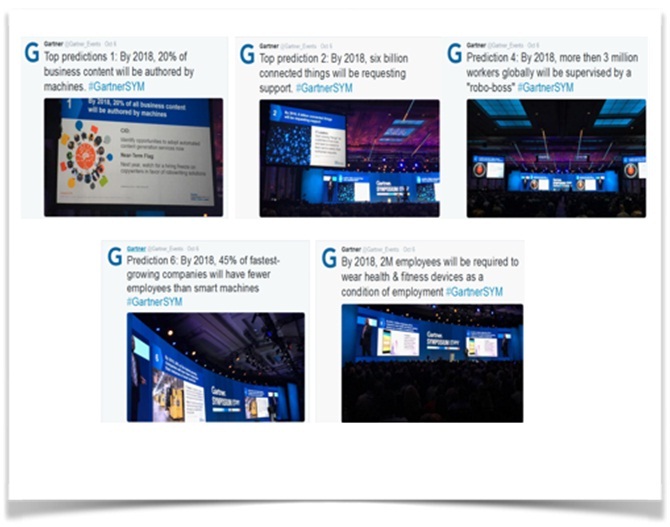At the just concluded Gartner Symposium, Daryl Plummer presented at Gartners Top 10 strategic predictions for 2016. (https://twitter.com/Gartner_Events). Here are some of the trends that I thought was going to change how we look at ‘workforce’ dramatically. I believe organizations will have to be razor sharp to keep up with the pace at which technology and the digital trends around us are changing.
What do these trends indicate? As we move up the digital scale, workplaces are increasingly going to use machines and technology for rudimentary and basic jobs. Those that are routine have already started to get automated, but with machines programmed with artificial intelligence and sensors, technology would be able to judge, take decisions and execute operations without too much human intervention. Plummer in his introduction also said the relationship between people and machines will go from cooperative to co-dependent to competitive. We also need to take into account that by 2020, there will be 25 billion connected devices (again as per Gartner’s report) instigated by the “Nexus of Forces” (cloud, mobile, social and information) who will be interacting and sharing data on our behalf.
Even if the Gartner strategy trends are only speculative, with a probability of only some predictions that could be eventually adopted, these trends do give a general idea of what areas could become mainstream. For example, take the case of Henn na Hotel (aka “strange hotel” in English) in Japan. The entire staff of this hotel are robots and facial recognition is the key to unlock the door. (http://in.pcmag.com/robotics-automation/43085/news/futuristic-japanese-hotel-staffed-entirely-by-robo) The reality of robotics is here, but how quickly and how pervasive will their use be, is not something that we know for sure.
In stark contrast, most business trends on organizational developmental is extremely short-sighted. I would go as far as to say, that organization developmental trends just state the current obvious and really does not give any indication on how the ecosystem changes are going to change how we do business. Human Resource trends for instance, still talk about HR analytics in decision making and the disappearing performance appraisal systems as the two major trends across most businesses. There is a huge amount of data/study that is available on how the millennial generation will bring some shifts in how organizations will work. But all these studies are stand-alone. There are really no credible reports that can help understand how all external environments impact organization development.
It almost appears that there is a generation gap between technology and organization development trends. What it actually means is that agility of technology is going to be a disruptive factor in our daily lives- at work and otherwise. However all organizations are not going to be quick enough to adapt to those changes. Companies that are part of the disruptive idea, will pioneer trends in organization development as well. Other firms will have to try and make giant leaps to play catch-up but now at a much more hurried pace. For example skills, hiring, staffing, policies, offices etc will all undergo paradigm shifts, with the changes in highly digitized organization. Interestingly, some external trends could also force organizations to alter policies – for e.g. one trend states that health & fitness devices might soon start becoming a condition for employment. I assumed these will be really useful in industries where physical fitness is already a mandatory criterion like- police, military, airlines etc. However, as per Gartner, wearing fitness devices will become commonplace and how the fitness data of employees will be used, will require IT leaders to determine policies around them.
Technology as a disruptive trend is a reality and not all organizations or industries are going to feel a similar impact of these trends. But it is definitely worth remembering that the ecosystem too needs to evolve as quickly to maximise benefits.









